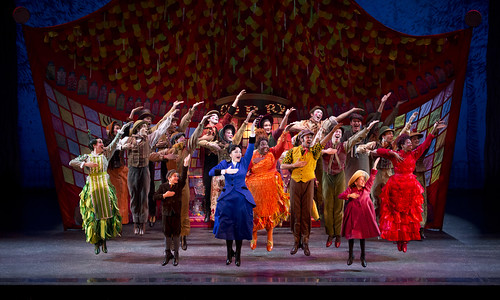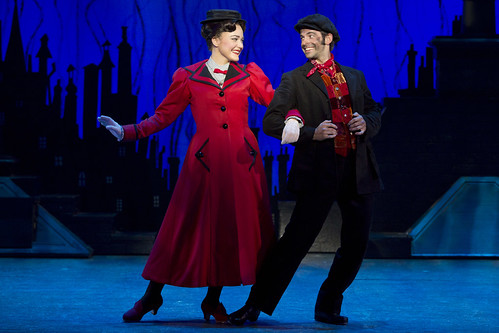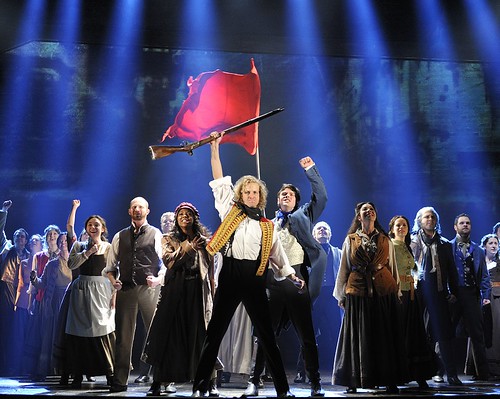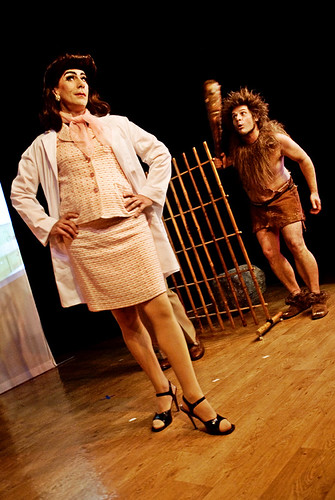
ABOVE: The ensemble performs “One Day More” from the touring production of Les Misérables running at San Francisco’s Orpheum Theatre through July 23 as part of the BroadwaySF season. BELOW: Christine Heesun Hwang is an excellent Éponine. Photos byMatthew Murphy & Evan Zimmerman for MurphyMade
When the “new-and-improved” version of Les Misérables came through San Francisco 11 years ago in celebration of the never-ending musical’s 25th anniversary, the big news was that this thoroughly re-staged version had banished the famous turntable that kept the epic’s action spinning and, most famously, the barricade barricading. That version of the tour is back at the Orpheum Theatre as part of the BroadwaySF season, and everything I said about that production then (read my review here) still stands. Happily, the highly annoying projections have been somewhat minimized, although the lighting in general seems so dim it’s like they’re trying to disguise any wear and tear on what is undoubtedly a worn and torn touring production. The version we saw in 2012 felt so much like a video game it was surprising the Playbill didn’t come with a joystick to help guide Jean Valjean through the sewers of Paris. This one feels slightly less so, but the projections are so anodyne they may as well not even be there.
I first saw Les Misérables in London in the fall of 1986. I had fallen in love with the two-cassette cast album, and from my seat in the Palace Theatre way (waaaaayyy) up in what the British call the “angels” seats (because you’re so close to heaven), the show I saw left me cold. I was at such a high altitude that I could see what was happening in front of and behind the barricade and could watch costume changes (Look! Fantine is changing her wig!) and other stage business that was best left unseen. A few months later, I splurged for an orchestra seat and liked the show better but still not as much as I liked simply listening to the score. Then, in 1989, I saw the touring production that spent many months at San Francisco’s Curran Theatre. I was in the second row, and it was Easter Sunday. It was like seeing an entirely different show. I loved it and then proceeded to see it at least five more times across the next two decades.
The tour I saw in 2012 and the current tour have convinced me that my time with Les Miz has come to an end. I’m back to feeling like I’m in the angels seeing something that is, essentially, empty spectacle that no amount of flash and volume can mask. The actors don’t act so much as indicate, and every song, from “I Dreamed a Dream” to “On My Own” to “Bring Him Home” is sung so forcefully and with the expectation of blowing the audience’s collective mind that there’s no room for the song to actually live and breathe. It’s like Broadway’s greatest hits of the ’80s as performed on – take your pick – “American Idol,” “The Voice” or “America’s Got Talent.” The acting makes the show feel even more like an opera because it’s all show-offy singing and cardboard characters.
Producer Cameron Mackintosh keeps the Misérables machine running, even if it’s probably best to let it rest so that fans can actually start to miss it before it comes back yet again. The show’s press release claims the 1985 musical has been seen by more than 130 million people worldwide in 53 countries and 22 languages. The original Broadway production ran for 16 years and there have already been two revivals: in 2006, only three years after the original closed, and in 2014.
Mackintosh also likes to celebrate the show’s anniversaries with lavish concerts that spawn TV specials and albums. He did that for the 10th and the 25th, and while the London production was temporarily moved out of its theater to make way for renovations, Mackintosh kept the show going in a concert version that kept getting extended (and was eventually televised). For these concerts, multiple old cast members show up, as do choirs and every stringed instrument in England. It’s somewhat ironic that as the touring show gets smaller, the concert productions just get insanely huge. Perhaps he’ll broadcast from space for the upcoming 40th anniversary. Or maybe craft an entirely, cost-saving AI company. Seriously, the Les Miz holographic experience can’t be far away.
It’s also ironic that the musical misery that pours forth from the show makes audiences so happy. For three hours, the audience applauds its way through the abuse of sex workers, abuse of children, murder of children, abuse of prisoners, corrupt policing, suicide, theft, psychotic vengeance, poverty, confusing (ultimately deadly) political ideology and performances that are all costumes and vocal chords rather than living, breathing humans. Side note: there’s an interesting lyric change in the current production when Théndardier is looting his way through “Beggar at the Feast.” The original lyric was: “Here comes a prince. There goes a Jew. This one’s a queer. But what can you do?” The new lyric replaces that last line with “I might try it, too.”
Through all the changes to the production, I try to remember what made me love Les Misérables more than 30 years ago, and I still get pangs of that affection in the big, flag-waving numbers “One Day More” and “Do You Hear the People Sing?” and in the finale when we hear the lyric, “To love another person is to see the face of God.” I understand the changes that have been made to make producing the show less expensive – I imagine we’ll even get a turntable-free production of Hamilton at some point. But I don’t need to experience Les Miz again until it is seriously revived in a whole new production. Maybe in 20 years or so when I’m in my 70s and some hotshot director has a new vision to crack open the show for a new generation. Undoubtedly, the ever-youthful Mackintosh will still be around to make sure that version runs for at least another half century.
FOR MORE INFORMATION
Les Misérables continues through July 23 at the Orpheum Theatre, 1182 Market St., San Francisco, as part of the BroadwaySF season. Running time: about 3 hours (including one intermission). Tickets are $60.50-$225.50 (subject to change). Call 888-746-1799 or visit broadwaysf.com






 He’s playing Headmistress Hymen, whose school, St. Godley’s Academy for Young Ladies, is about to go bankrupt. So, in true musical theater fashion (think Nunsense), she and her girls stage a musical version of Melville’s Moby Dick to raise some much needed funds. Headmistress, of course, takes on the role of Capt. Ahab.
He’s playing Headmistress Hymen, whose school, St. Godley’s Academy for Young Ladies, is about to go bankrupt. So, in true musical theater fashion (think Nunsense), she and her girls stage a musical version of Melville’s Moby Dick to raise some much needed funds. Headmistress, of course, takes on the role of Capt. Ahab.
 In recent years he (with roommate Finn) adapted the horrible Joan Crawford B-movie horror flick Trog for the stage. The show was so successful here they took it on the road to Los Angeles.
In recent years he (with roommate Finn) adapted the horrible Joan Crawford B-movie horror flick Trog for the stage. The show was so successful here they took it on the road to Los Angeles.

